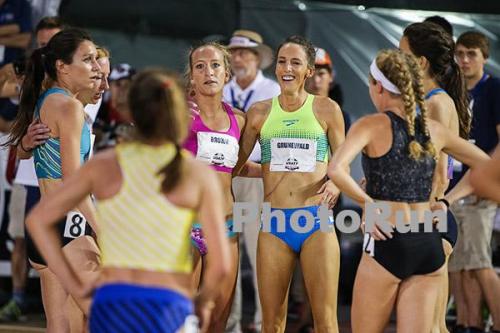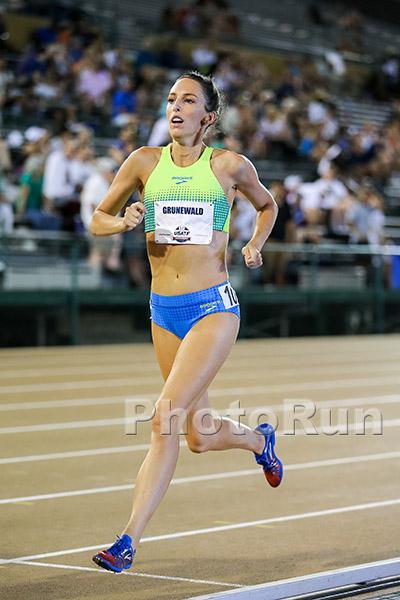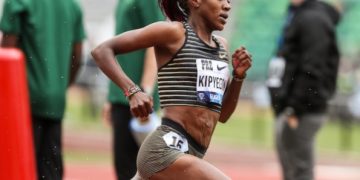Steve Ritchie is a fine journalist hailing from Oregon. I met him over the last three Olympic Trials as he represented various media groups. I enjoyed his writing and our conversations. I asked him to cover the various media covering the 2017 US Champs, from June 22-June 25. Here is his first column, on NBC sports gold.
Why do we review media coverage, as we have since 2004? Because we want to see our sport thrive and we believe that providing a critical review of media coverage is key to improving that coverage. Please enjoy Steve Ritchie’s review.
 Gabe Grunewald, after her 1,500m heat, photo by PhotoRun.net
Gabe Grunewald, after her 1,500m heat, photo by PhotoRun.net
 Gabe Grunewald, photo by PhotoRun.net
Gabe Grunewald, photo by PhotoRun.net
NBC Sports Gold Coverage of US Championships
By Steve Ritchie for RunBlogRun
I didn’t immediately sign up for the NBC Sports Gold track and field annual package when it was announced earlier in 2017. My hesitation was partly due to the $69.95 cost, when I am already paying a monthly cable bill that includes the NBC Sports Channel, which covers all the Diamond League meets.
Frankly, however, it was also because I wasn’t sure how many hours I wanted to spend at my computer watching track meets, as well as marathon and road races. But when I decided not to travel to Sacramento for the USATF Championships, I knew I had to have some way to see ALL of the meet or I would go crazy.
So, a couple days before the meet, I signed up. It was, without a doubt, a very good decision. Had I been content to just check twitter and event results, I would have missed some incredible viewing. More on that in a bit.
On Thursday afternoon, I settled in to watch the men’s hammer final at 1:45 pm, knowing that with the last event – men’s 10K – set for 10 pm, it was going to be a long day of viewing.
Initially, the meet coverage was underwhelming. I love watching the hammer throw in person, but this did not work for me. There appeared to be just one camera in use, and it was positioned behind the landing area. The effect was that the viewer could see the spin, the release and the flight of the hammer, but you could not tell with any certainty how long the throw was.
The announcing of Tim Hutchings and Dan O’Brien was competent, but it was hard to track the standing of the athletes as they moved through the rounds.
At times, when the thrower entered the ring, there was a graphic on the screen showing the athlete’s current place and their series of throws. But it wasn’t consistent, and many throwers came and went with no graphic.
The single camera also made it impossible to show close-up views of the throwers. I missed seeing their reactions to their throws, and missed seeing how so many implements never made it out of the cage. With no mic near the ring, you couldn’t hear the crowd clapping or the athletes grunting. It was like watching from a distance without binoculars. Not exactly riveting.
Things improved considerably when the action started on the track at 5 pm. Once the races began, there were only occasional cutaways to the action in the field. But, still, it was more than we usually get from TV coverage of field events, and it was in real time, which was a plus.
Visually, the track coverage was a huge improvement over the hammer event. Seeing the entire 10Ks without commercial interruption was almost worth the entire cost of the annual package, since both the Huddle-Flanagan duel and the Sam Chelanga surges were fascinating viewing.
I also have to say that the announcing duo of Hutchings and Carrie Tollefson was very good throughout the running events. They are both knowledgeable, and delved into topics that I found interesting as a track fan. Things like has marathon training taken something out of Galen Rupp’s kick, or which male 10K runner might decide to push the pace like Shalane did in the women’s 10K, or which of the top women had the best form late in the race.
Aside from Hutchings occasionally losing track of whether it was the top three or the top four who qualified automatically for the next round, both of them were accurate, incisive and amiable. In addition, they had good chemistry together. It was enjoyable to hear them bantering when they disagreed about something. Without question, Tollefson has star quality and excellent background in running; I would like to see her used by NBC as a color commentator anytime there is a distance race.
The things I was glad that I didn’t miss on day one?
– Ben Blankenship’s Houdini-like move to break out of a box and into the lead in the 1500 with one lap to go;
– Alysia Montano running 2:21 in 108 degree heat while four months pregnant;
– Nick Symmonds in possibly his last major track race;
– NCAA D2 1500 meter champ David Ribich, a junior at Western Oregon, my alma mater, qualifying for the finals on time;
– Three current Oregon Ducks and one former Oregon Duck qualifying in one heat of the women’s 100 meters;
– Stephanie Garcia seemingly losing her water jump confidence mid-race;
– Each one of the six 1500 meter heats which were all enthralling.
Best of all was seeing Gabe Grunewald’s competitors gather around her after the 1500 heat, arms around each other with Gabe in the middle. We couldn’t hear what was said but the picture was incredibly moving.
After day one, I am sorry not to be in Sacramento, but very happy I signed up for NBC Sports Gold.





















